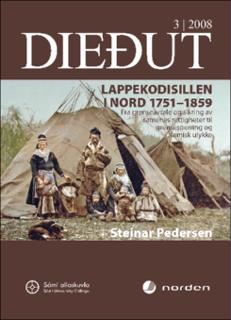| dc.contributor.author | Pedersen, Steinar | |
| dc.date.accessioned | 2012-07-09T08:32:39Z | |
| dc.date.available | 2012-07-09T08:32:39Z | |
| dc.date.issued | 2006 | |
| dc.identifier.isbn | 978-82-7367-018-2 | |
| dc.identifier.issn | 0332-7779 | |
| dc.identifier.uri | http://hdl.handle.net/11250/177104 | |
| dc.description | Betydelige deler av de nordiske statene, og den nordvestligste delen av Russland, var opprinnelig samiske bosettingsområder. I 1751 ble det trukket en fast og bestemt grense mellom Sverige (m/Finland) og Norge, som skar gjennom sentrale samiske bruksområder fra Midt- Skandinavia og nordover. Statene – Danmark-Norge og Sverige – anerkjente i den forbindelse samene som et eget folk med grunnleggende rettigheter. De laget derfor regler for å sikre at ”den Lappiske Nation” fortsatt skulle kunne bestå. Det skjedde gjennom et tillegg til grensetraktaten – senere kalt Lappekodisillen. De berørte samene kk etter gammel sedvane, full adgang til å bruke naturgodene på begge sider av grensen. Dette gjaldt reindrift, jakt og ske, herunder sjø ske og seljakt. Det ble også gitt bestemmelser om valg av samenes statsborgerlige tilhørighet, samisk nøytralitet i tilfelle krig, interne samiske administrasjonsordninger, en intern samisk domstol – ”Lapperetten”, og full handelsfrihet i Norge for de nordligst boende svenske samene. Denne avhandlingen gir et bilde av Lappekodisillens anvendelse og status fra 1751 til 1859, på den nåværende grensen mellom Norge og Finland (Sverige før 1809). Kodisillen gjaldt her fullt ut til grensesperringen i 1852, og ble også anvendt i forhold til ikke-reindriftssamer. Fremstillingen avsluttes i 1859, da Finland ønsket å gi den nordligste delen av landet til Norge, for at samene skulle kunne bruke naturgodene som tidligere. | no_NO |
| dc.description.abstract | Lappekodisilla davvin 1751−1859.
Rádjášiehtadusas ja sámiid vuoigatvuođaid sihkkarastimis ráji giddemii ja sámiid lihkohisvuhtii.
Stuorra oasit davviriikkaid stáhtain, ja Davvioarje-Ruoššas, ledje álgoálggus sámi ássanguovllut. Jagi 1751 gessojuvvui bistevaš, mearriduvvon rádjá Ruoŧa (masa gulai Suopma) ja Norgga gaskii. Rádjá vajastii guovdat guovddáš sámi geavahanguovlluid Gaska-Skandinávias davás. Stáhtat – Dánmárku-Norga ja Ruoŧŧa – dovddastedje dan oktavuođas sápmelaččaid sierra álbmogin, mas leat vuođđovuoigatvuođat. Dat ráhkadedje danin njuolggadusaid, maiguin áigo sihkkarastit ahte ”sámiid našuvdna” bisttášii. Dat dahkkojuvvui rádjášiehtadusa lasáhusain, mii lea maŋŋá gohčoduvvon Lappekodisillan. Sápmelaččat geaidda ášši guoskkai besse boares vieruideaset mielde ollásit ávkkástallat luondduvalljodagaiguin goabbat bealde rájá. Dat guoskkai boazodollui, bivdui ja guolásteapmái, maiddái mearrabivdui ja njurjobivdui. Dahkkojuvvojedje maiddái mearrádusat, mat guske sámiid stáhtaborgárvuhtii, sámiid neutralitehtii soađis, sámiid siskkáldas hálddašanortnegiidda, sámi siskkáldas duopmostullui (“Lapperetten”), ja dievas gávppašanfriijavuhtii Norggas, mii guoskkai Ruoŧa beale davimus guovlluid sápmelaččaide. Dát girji govvida Lappekodisilla geavahusa ja stáhtusa áigodagas 1751─1859 dálá Norgga ja Suoma (Ruoŧa ovdal 1809) rájá guovdu. Kodisilla lei ollásit fámus rájá giddema rádjái 1852 ja geavahuvvui earáid ge, go dušše boazosápmelaččaid guovdu. Govvádus nohká jahkái 1859, goas Suopma háliidii addit riikka davimus oasi Norgii, vai sápmelaččat sáhtášedje geavahit luondduvalljodagaid nu mo ovdalge. | no_NO |
| dc.description.abstract | The Lapp Codicil in the far north 1751-1859.
From a Border Agreement and the Recognition of Sami Rights to Closing of the Border and Sami Discontent.
Extensive parts of the Nordic states and the north-western part of Russia were originally Sami settlement areas. In 1751, a fixed and clearly demarcated border was drawn between Sweden (incl. Finland) and Norway that cut through central areas that had been long used by the Sami from Central Scandinavia northwards. In conjunction with this borders establishment, the nation states – Denmark- Norway and Sweden recognised the Sami as a separate people with fundamental rights. They therefore adopted rules intended to ensure the continued existence of the ‘Lapp Nation’. This was effected through an addendum to the border treaty which was later called the Lapp Codicil. In accordance with old rights of usage, the affected Sami people were given full rights to use the natural resources on both sides of the border. This applied to reindeer husbandry, hunting and fishing, which included sea fishing and hunting for seals. Provisions were also included concerning Sami people’s choice of citizenship, Sami neutrality in the event of war, internal Sami administrative arrangements and an internal Sami court – ‘the Lapp Court’, and the full freedom of trade in Norway for Swedish Sami people living in the northernmost regions. This book describes the application and status of the Lapp Codicil along the current border between Norway and Finland (Sweden until 1809) during the period from 1751 to 1859. The Codicil applied in full in this area until the border was closed in 1852 and it was also applicable to Sami people not engaged in reindeer husbandry. The account ends in 1859, when Finland wished to cede the northernmost part of the country to Norway in order to ensure that the Sami people could use the natural resources as before. | en |
| dc.language.iso | nob | no_NO |
| dc.publisher | Sámi allaskuvla / Sámi University College | no_NO |
| dc.relation.ispartofseries | DIEĐUT;3/2008 | |
| dc.subject | grenseavtale | no_NO |
| dc.subject | samiske rettigheter | no_NO |
| dc.subject | samenes rettigheter | no_NO |
| dc.subject | lappekodisill | no_NO |
| dc.subject | codisill | no_NO |
| dc.title | Lappekodisillen i nord 1751-1859: Fra grenseavtale og sikring av samenes rettigheter til grensesperring og samisk ulykke | no_NO |
| dc.title.alternative | | no_NO |
| dc.type | Doctoral thesis | no_NO |
| dc.subject.nsi | VDP::Humanities: 000::History: 070::Political history: 071 | no_NO |
| dc.subject.nsi | VDP::Social science: 200::Political science and organizational theory: 240::International politics: 243 | no_NO |
| dc.subject.nsi | VDP::Humanities: 000::The study of folklore, Ethnology: 100::Ethnology: 102 | no_NO |
| dc.source.pagenumber | 540 | no_NO |
